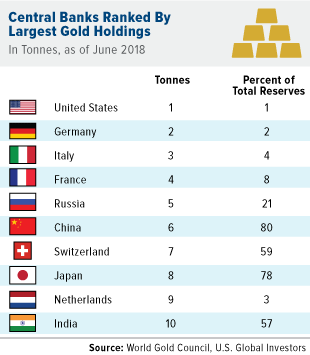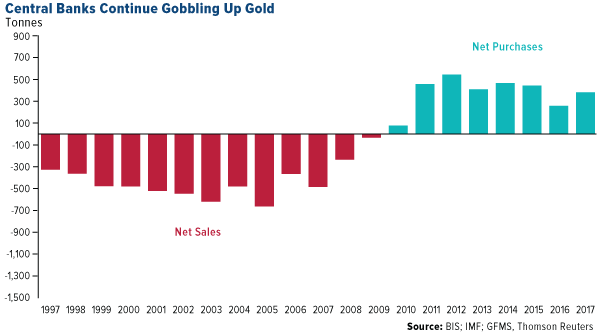Beginning in 2010, central banks around the world turned from being net sellers of gold to net buyers of gold. Last year official sector activity rose 36 percent to 366 tonnes – a substantial increase from 2016.
The top-10 central banks with the largest gold reserves have remained mostly unchanged for the last few years. The United States holds the number one spot with over 8,000 tonnes of gold in its vaults – nearly as much as the next three countries combined. For six consecutive years the Russian Central Bank has been the largest purchaser of gold, increasing its holdings by 224 tonnes in 2017 and overtaking China to hold the fifth spot, according to the GFMS Gold Survey.
Not every central bank is a net buyer. For the second year in a row, Venezuela has been the largest seller of gold, with 25 tonnes sold last year to help pay off debt. However, gross official sector sales declined by 55 percent last year, to the lowest since 2014, indicating that central banks are happy to keep their reserves in gold, historically viewed as a safe-haven asset.
2018 could be another strong year for central bank gold demand. According to the World Gold Council(WGC), demand in the first quarter was up 42 percent year-over-year, with purchases totaling 116.5 tonnes for the highest first quarter total since 2014. As global debt continues to skyrocket, central banks and individual investors alike might want to keep gold in their pockets, as it historically has performed well during times of economic downturn and geopolitical uncertainty.
Below are the top 10 countries with the largest gold holdings, beginning with India.
10. India
Tonnes: 560.3
Percent of foreign reserves: 5.5 percent
It’s no surprise that the Bank of India has one of the largest stores of gold in the world. The South Asian country, home to 1.25 billion people, is the second largest consumer of the precious metal, and is one of the most reliable drivers of global demand. India’s festival and wedding season, which runs from October to December, has historically been a huge boon to gold’s Love Trade.
9. Netherlands
Tonnes: 612.5
Percent of foreign reserves: 68.2 percent
The Dutch Central Bank announced that it will be moving its gold vaults from Amsterdam to Camp New Amsterdam, about an hour outside the city, citing burdensome security measures of its current location. As many others have pointed out, this seems odd, given that the bank fairly recently repatriated a large amount of its gold from the U.S.
8. Japan
Tonnes: 765.2
Percent of foreign reserves: 2.5 percent
Japan, the world’s third largest economy, is also the eighth largest hoarder of the yellow metal. Its central bank has been one of the most aggressive practitioners of quantitative easing—in January 2016, it lowered interest rates below zero—which has helped fuel demand for gold around the world.
7. Switzerland
Tonnes: 1,040.0
Percent of foreign reserves: 5.3 percent
In seventh place is Switzerland, which actually has the world’s largest reserves of gold per capita. During World War II, the neutral country became the center of the gold trade in Europe, making transactions with both the Allies and Axis powers. Today, much of its gold trading is done with Hong Kong and China.
6. China
Tonnes: 1,842.6
Percent of foreign reserves: 2.4 percent
In the summer of 2015, the People’s Bank of China began sharing its gold purchasing activity on a monthly basis for the first time since 2009. Although China comes in sixth for most gold held, the yellow metal accounts for only a small percentage of its overall reserves – a mere 2.4 percent – the lowest of the top 10 central banks with the most gold. However, this figure is up slightly from 2.2 percent of holdings in 2016.
China is also the number one gold producing nation. What other countries are top gold producers?
5. Russia
Tonnes: 1,909.8
Percent of foreign reserves: 17.6 percent
The Russian Central Bank has been the largest buyer of gold for the past six years and earlier this year overtook China to have the fifth largest reserves. In 2017 Russia bought 224 tonnes of bullion in an effort to diversify away from the U.S. dollar, as its relationship with the West has grown chilly since the annexation of the Crimean Peninsula in mid-2014. To raise the cash for these purchases, Russia sold a huge percentage of its U.S. Treasuries.
4. France
Tonnes: 2,436.0
Percent of foreign reserves: 63.9 percent
France’s central bank has sold little of its gold over the past several years, and there are calls to halt it altogether. Marine Le Pen, president of the country’s far-right National Front party, has led the charge not only to put a freeze on selling the nation’s gold but also to repatriate the entire amount from foreign vaults.
3. Italy
Tonnes: 2,451.8
Percent of foreign reserves: 67.9 percent
Italy has likewise maintained the size of its reserves over the years, and it has support from European Central Bank (ECB) President Mario Draghi. The former Bank of Italy governor, when asked by a reporter in 2013 what role gold plays in a central bank’s portfolio, answered that the metal was “a reserve of safety,” adding, “it gives you a fairly good protection against fluctuations against the dollar.”
2. Germany
Tonnes: 3,371.0
Percent of foreign reserves: 70.6 percent
Last year Germany completed a four-year repatriation operation to move a total of 674 tonnes of gold from the Banque de France and the Federal Reserve Bank of New York back to its own vaults. First announced in 2013, the move was expected to take until 2020 to complete. Although gold demand fell last year after hitting an all-time high in 2016, this European country has seen gold investing steadily rise since the global financial crisis.
1. United States
Tonnes: 8,133.5
Percent of foreign reserves: 75.2 percent
With the largest official holdings in the world, the U.S. lays claim to nearly as much gold as the next three countries combined. It also has the highest gold allocation as a percentage of its foreign reserves at over 75 percent. From what we know, the majority of U.S. gold is held at Fort Knox in Kentucky, with the remainder held at the Philadelphia Mint, Denver Mint, San Francisco Assay Office and West Point Bullion Depository. Which state loves gold the most? Well, the state of Texas went so far as to create its very own Texas Bullion Depository to safeguard investors’ gold.
Can't get enough of gold? Learn all about the yellow metal's seasonal trading patterns by downloading our free whitepaper, Gold's Love Trade, today!
All opinions expressed and data provided are subject to change without notice. Some of these opinions may not be appropriate to every investor. By clicking the link(s) above, you will be directed to a third-party website(s). U.S. Global Investors does not endorse all information supplied by this/these website(s) and is not responsible for its/their content.
U.S. Global Investors, Inc. is an investment adviser registered with the Securities and Exchange Commission ("SEC"). This does not mean that we are sponsored, recommended, or approved by the SEC, or that our abilities or qualifications in any respect have been passed upon by the SEC or any officer of the SEC.
This commentary should not be considered a solicitation or offering of any investment product.
Certain materials in this commentary may contain dated information. The information provided was current at the time of publication.
